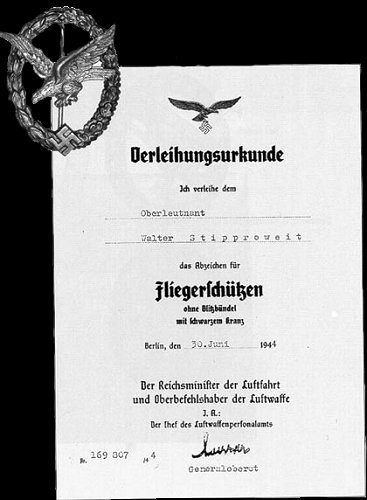
by Mark Miller
On June 22, 1942, the Air Gunnerís and Flight Engineerís Badge was instituted. The badge was worn by all Luftwaffe air gunners, flight engineers, and aircrew meteorologists, who completed two months training or had participated in five operational flights. The badge could be awarded sooner if the recipient was wounded during an operational flight.
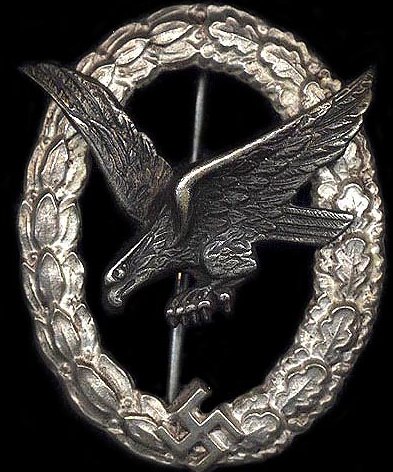
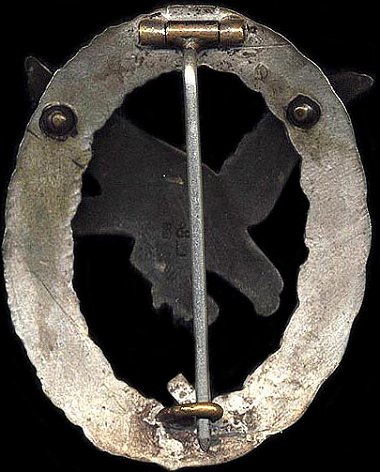
Air Gunnerís and Flight Engineerís Badge; Berg & Nolte, Ludenscheid
(M. Miller Collection)
Manufacturing and Technical Information
Quality examples were initially made in Tombak, but most examples found will be constructed of zinc or kreigsmetal. The silver plated wreath is in the shape of an oval, with a slightly convex design. On the front of the badge, the wreath is covered half with oak leaves and the other half in laurel leaves. In the center of the wreath at the bottom is a swastika. Mounted in the center of the wreath is an eagle in flight, diving to the left. Most badges were produced with the eagle in the same metal as the wreath. While seldom encountered, some versions may have been constructed with an aluminum eagle on a zinc wreath. The eagle is darkened, finished in alt-silver, deep blued, or anodized black. The highlights of the wreath and the swastika are polished. Some examples exhibit a cut-out upper arm of the swastika.
The top arm of the swastika was cutout early in the war and was generally left filled in as the war progressed. The eagleís rear claw/talon should be clearly defined on originals. Many post-war fakes omitted this feature.
The following is a partial list of makers and is not exhaustive:
Assmann
B&NL
BSW
Deumer
Imme (JMME)
Juncker
Unmarked
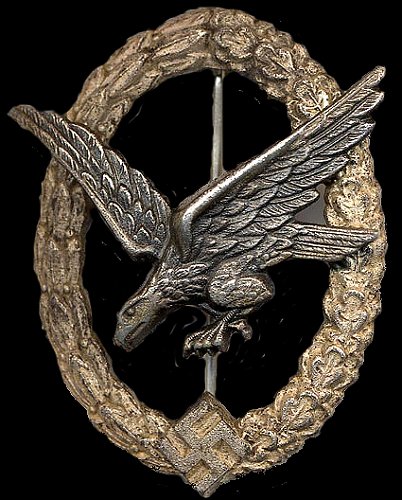
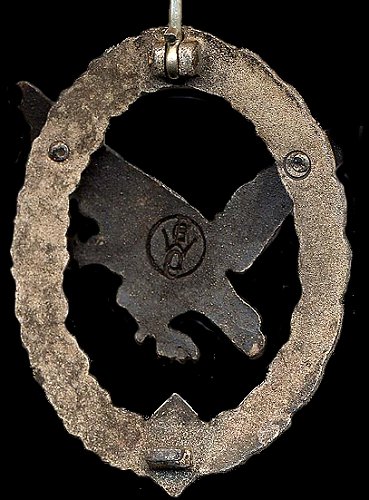
Air Gunnerís and Flight Engineerís Badge; Gebruder
Wegerhoff, Ludenscheid
(John Garcia Collection)
The reverse of the badge incorporates an attaching device consisting of a hinge assembly, a vertical pin, and a catch. Many types and styles were utilized from manufacturer to manufacturer. Different assemblies can even be seen from a single manufacturing firm. The eagle is attached to the wreath by two rivets protruding through the wreath. On many examples, a manufacturers hallmark can be seen stamped into the rear of the
eagle.
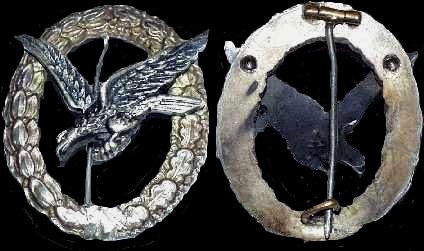
Air Gunnerís and Flight Engineerís Badge; F.W. Assmann
& Sohn , Ludenscheid
(Courtesy Detlev Niemann)
While measurements vary from badge to badge, approximate characteristics are as follows:
-
Wreath -
- Height - 53mm
- Width- 40mm
- Eagle Wingspan - 42mm
- Weight - 30-40g
Cloth versions of this badge were made. Overall dimensions are similar to the metal version. Also, as the war neared an end, Radio Operator/ Air Gunnerís badges were often modified to an Air Gunnerís and Flight Engineerís badge style by removing the lightning bolts (blitzbundel) with a file. The Air Gunnerís and Flight Engineerís badge is generally identifiable by the distinct, separated, rear protruding talon of the eagle. A modified Radio Operator/ Air Gunnerís badge generally shows the talons tightly together.
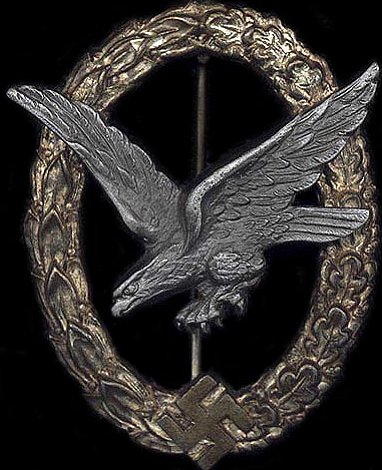
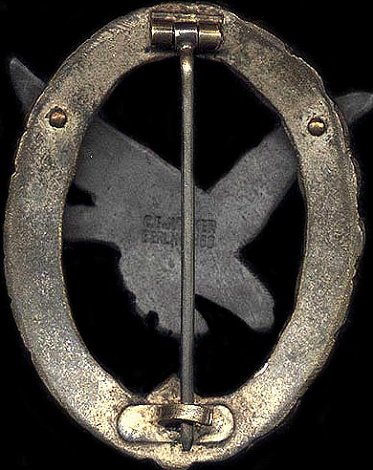
Flat wire
catch applied to Oval mounting plate; C.E. Juncker, Berlin SW68
(MMiller Collection)
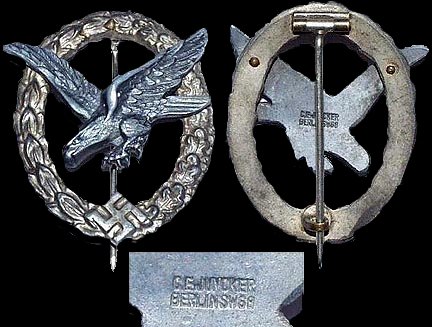
Flat wire catch applied to Circular mounting plate; C.E. Juncker, Berlin SW68
(Courtesy Detlev Niemann)
Presentation, Wear and Documents
The Air Gunnerís and Flight Engineerís Badge was awarded in a dark blue case. The interior had a blue satin upper lid lining, and blue flocking in the lower base. The two halves were hinged in the rear and secured by a spring tension pin/ catch device. Across the exterior lid was embossed Luftwaffen= Fliegerschutzen= Abzeichen, or Bordmechanikerabz, in silver lettering. The badge was to be worn on the recipientís left side, on or near the pocket, and below the Iron Cross 1st Class.
Each recipient of the Air Gunnerís and Flight Engineerís Badge had an entry made in his Soldbuch. An additional Award Document was presented at a later date.
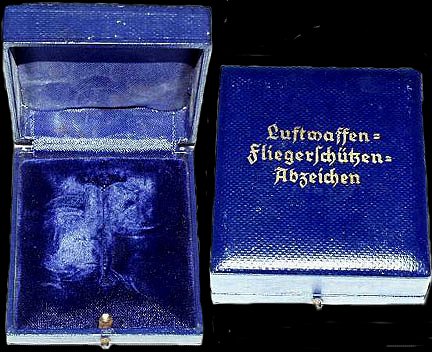
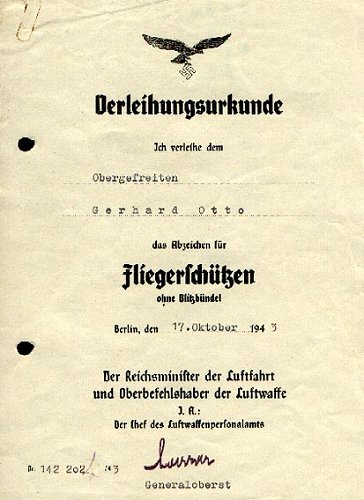
Presentation Case - Award Document
(Courtesy Jacques Calero)
Award Criteria
Personnel who completed two months of training or participated in five operational flights were qualified to receive the Air Gunner & Flight Engineer Badge. If the recipient was wounded during an operational flight the badge could be awarded earlier.
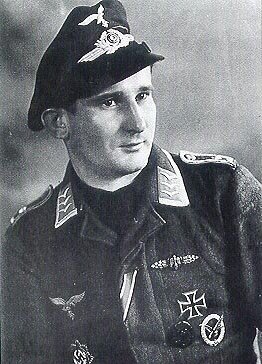
(Courtesy Francois Saez)
Unqualified Air Gunnerís/ Flight Engineerís Badge (Fliegerschutzenabzeichen mit Schwarzem Kranz)
On April 25, 1944, the Unqualified Air Gunnerís and Flight Engineerís Badge was instituted. The badge was presented to personnel, acting in the capacity of gunners, who had taken part in a minimum of ten combat flights. The number could be lowered if the recipient was wounded during one of the flights. This lowering of the requirements was an obvious dire attempt to man the aircraft, as most of the qualified gunners had succumbed to the fortunes of war.

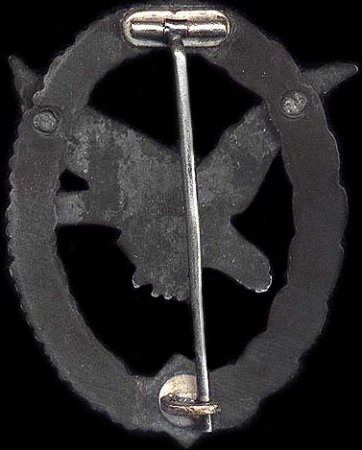
Unqualified Air Gunnerís and Flight Engineerís Badge; Wilhelm Deumer, Ludenscheid
(MMiller Collection)
|
(Courtesy Detlev Niemann) |
The design of the badge was identical to the 1942 pattern, with the exception that the colors of the wreath were reversed - i.e.- a black wreath and a silver eagle. It is unlikely that the badge was ever produced in any other metals than zinc or kreigsmetal. No special presentation case was designed. However, unique award documents (while rare) do exist. Award Document for Unqualified Air Gunner and Flight Engineer. Interesting to note that the recipient was an Oberleutnant. As gunners usually were Enlisted Men, it is conceivable that the recipient may have been an Officer in some other branch of the Luftwaffe (Signals, Administration, etc.), but was transferred into the Flight branch, who was in desperate need of manpower at this critical time of the war. |
![]()
© Copyright Wehrmacht-Awards.com LLC |
